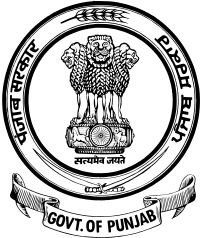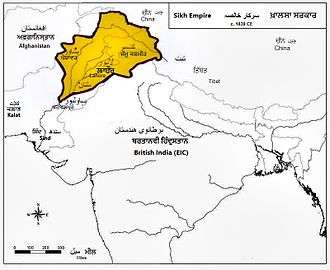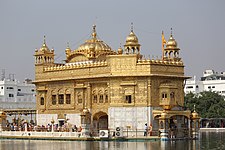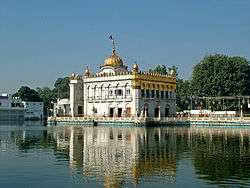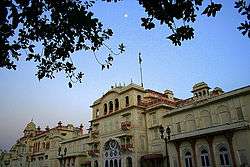Punjab, India
Punjab (/pʌnˈdʒɑːb/ (![]()
Punjab | |
|---|---|
  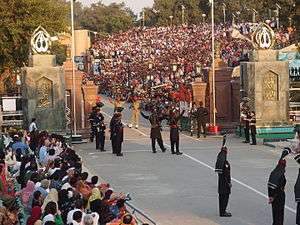  Clockwise from top : Golden Temple, Wagah border, Gobindgarh Fort, Punjabi Bhangra dance, Jallianwala Bagh memorial | |
| Etymology: Panj (means five) and āb" (means waters) | |
 Location of Punjab in India | |
| Coordinates (Chandigarh): 30.79°N 75.84°E | |
| Country | |
| Capital | Chandigarh† |
| Largest city | Ludhiana |
| Districts | 22 |
| Government | |
| • Body | Government of Punjab |
| • Governor | V P Singh Badnore |
| • Chief Minister | Amarinder Singh (INC) |
| • Legislature | Unicameral (117 seats) |
| • Parliamentary constituency | |
| • High Court | Punjab and Haryana High Court†† |
| Area | |
| • Total | 50,362 km2 (19,445 sq mi) |
| Area rank | 19th |
| Highest elevation | 551 m (1,808 ft) |
| Lowest elevation | 150 m (490 ft) |
| Population (2011)[1] | |
| • Total | 27,743,338 |
| • Rank | 16th |
| • Density | 550/km2 (1,400/sq mi) |
| Demonym(s) | Punjabi |
| GDP (2020-21) [2] | |
| • Total | ₹6.44 lakh crore (US$90 billion) |
| • Per capita | ₹153,061 (US$2,100) |
| Time zone | UTC+05:30 (IST) |
| ISO 3166 code | IN-PB |
| HDI (2018) | |
| Literacy (2011) | 76.68% |
| Official language | Punjabi[6] |
| Website | punjab |
| ^† Joint Capital with Haryana. ††Common for Punjab, Haryana and Chandigarh. | |
| Symbols of Punjab | |
| Emblem | Emblem of Punjab (Lion Capital of Ashoka with Wheat stem (above) and Crossed Swords (below)) |
| Language | Punjabi |
| Dance | Bhangra, Giddha |
| Mammal | Blackbuck |
| Bird | Baaz[7] (Accipiter gentilis) |
The history of Punjab has witnessed the migration and settlement of innumerable races, forming a melting pot of Punjabi civilisation. The first traces of human habitation in India were found in the Punjab region.[15] The Indus Valley Civilization flourished in antiquity before recorded history until their decline around 1900 BCE.[16] The Punjab has had numerous recorded invasions, starting with the Aryan Vedic tribes. Punjab was enriched during the height of the Vedic period, but declined in predominance with the rise of the Mahajanapadas.[17] The region formed the frontier of initial empires during antiquity including the Achaemenid, Alexander's[18], Seleucid, and Maurya[19] Empires. After the fall of the Maurya Empire, the region was splintered into multiple kingdoms and republics. Punjab was subsequently conquered by the Kushan Empire, Gupta Empire[20], and then Harsha's Empire[21]. Punjab continued to be settled by nomadic people; including the Huna, Turkic and the Mongols. Circa 1000, the Punjab came under the rule of Muslims[22] and was part of the Delhi Sultanate[23][24], Mughal Empire[25][26], and Durrani Empire[27]. Sikhism was founded in the 1500s and 1600s by the Sikh Gurus in the Punjab and resulted in the formation of the Sikh Confederacy after the fall of the Mughal Empire and ensuing conflict with the Durrani Empire.[28][29][30][31] This confederacy was united into the Sikh Empire in 1801 by Maharaja Ranjit Singh.[32][33]
The greater Punjab region was annexed by the British East India Company from the Sikh Empire in 1849.[34] In 1947, the Punjab Province of British India was divided along religious lines into West Punjab and East Punjab, with 200,000 to 2 million Punjabis dying in related violence.[35][36][37][38][39] The western part was assimilated into Pakistan, an Islamic republic while the east became part of India, a secular state. After the Punjabi Suba movement, the Indian Punjab and PEPSU were divided into three parts on the basis of language in 1966.[40] Haryanvi and Hindi speaking areas (including various dialects) were carved out as Haryana, while the hilly regions and Pahari-speaking areas formed Himachal Pradesh, alongside the current state of Punjab. An insurgency occurred in Punjab during the 1980s.[41] Today, Punjab's government has three branches – executive, judiciary and legislative. Punjab follows the parliamentary system of government with the Chief Minister, currently Captain Amarinder Singh, as the head of government.[42] The Governor of Punjab, currently V.P. Singh Badnore, is a mostly ceremonial head of state appointed by the President of India; the Governor of Punjab has also served as the Administrator of Chandigarh as well since 1984.[43] The two major political parties in the state are the Shiromani Akali Dal, a right-wing party allied with the Bharatiya Janata Party at the national level, and the Indian National Congress, a left-wing party.[44]
The economy of Punjab is the 14th-largest state economy in India with ₹5.18 lakh crore (US$73 billion) in gross domestic product and a per capita GDP of ₹153,000 (US$2,100), slightly above the national average.[3][4] Punjab ranked first in GDP per capita amongst Indian states in 1981, fourth in 2001, and sixteenth in 2020.[45][46][47][48][49][50] Punjab has the ninth highest ranking among Indian states and union territories in human development index as of 2018.[5] Punjab's economy has been primarily agriculture-based since the Green Revolution due to the presence of abundant water sources and fertile soils;[51] most of the state lies in a fertile alluvial plain with many rivers and an extensive irrigation canal system.[52] Despite covering only 1.53% of its geographical area, Punjab makes up for about two-thirds of India's wheat production and one-third of its milk production, being known as India's breadbasket.[53] About 80%[54]-95%[55] of Punjab's agricultural land is owned by its Jat Sikh community despite it only forming 21%[56] of the state's population. About 10% of Punjab's population is made up of migrants from poorer states to the southeast such as Uttar Pradesh and Bihar who work as farm laborers.[57] Other major industries include financial services, the manufacturing of scientific instruments, agricultural goods, electrical goods, machine tools, textiles, sewing machines, sports goods, starch, fertilisers, bicycles, garments, and the processing of pine oil and sugar.[58] Minerals and energy resources also contribute to Punjab's economy to a much lesser extent. Punjab has the largest number of steel rolling mill plants in India, which are in "Steel Town"—Mandi Gobindgarh in the Fatehgarh Sahib district. Punjab also has a large diaspora that is mostly settled in the United Kingdom, the United States, and Canada, numbers about 3 million, and sends back billions of USD in remittances to the state, playing a major role in its economy.[59] The state's bustling tourism, music,[60][61] culinary, and film[62][63] industries contribute to the state's economy as well, and are amongst the largest in India despite the state's small size and population, including India's largest music industry.[64][65][66][67] Currently, the state is experiencing the COVID-19 pandemic[68] as well as an epidemic of drug usage.[69][70][71][72]
Etymology
The region was originally called Sapta Sindhu,[73] the Vedic land of the seven rivers flowing into the sea.[74] The Sanskrit name for the region, as mentioned in the Ramayana and Mahabharata for example, was Panchanada which means "Land of the Five Rivers", and was translated to Persian as Punjab after the Muslim conquests.[75][76] The word Punjab is a compound of the Persian words panj (five) and āb (waters). Thus Panjāb roughly means "the land of five rivers". The five rivers are the Sutlej, Beas, Ravi, Chenab and Jehlum (also spelled Jhelum). Traditionally, in English, there used to be a definite article before the name, i.e. "The Punjab". The name is also sometimes spelled as "Panjab".
The Greeks called Punjab a pentapotamia, an inland delta of five converging rivers;[77] the name Punjab was given to the region by the Central Asian Turkic conquerors of India, and popularised by the Turco-Mongol Mughals.[78][79]
History
Hinduism in Punjab
During the period when the epic Mahabharata was written, around 800–400 BCE, Punjab was known as Trigarta and ruled by Katoch kings.[80][81] The Indus Valley Civilization spanned much of the Punjab region with cities such as Ropar. The Vedic Civilization spread along the length of the Sarasvati River to cover most of northern India including Punjab, and this gave way for the formation and synthesization of Hinduism.
Sikhs in Punjab
Sikhism originated in the Punjab Region during the 15th century. Approximately 75% of the total Sikh population of the world lives in Punjab. Sikhism began at the time of the conquest of northern India by Babur. His grandson, Akbar, supported religious freedom and after visiting the langar of Guru Amar Das had a favourable impression of Sikhism. As a result of his visit he donated land to the langar and had a positive relationship with the Sikh Gurus until his death in 1605.[82] His successor, Jahangir, saw the Sikhs as a political threat. He arrested Guru Arjun Dev because of Sikh support for Khusrau Mirza[83] and ordered him put to death by torture. Guru Arjan Dev's martyrdom led to the sixth Guru, Guru Hargobind, declaring Sikh sovereignty in the creation of the Akal Takht and the establishment of a fort to defend Amritsar.[84]
Jahangir attempted to assert authority over the Sikhs by imprisoning Guru Hargobind at Gwalior. He felt compelled to release him when he began to suffer premonitions of an early and gruesome death. The Guru refused to be released unless the dozens of Hindu princes imprisoned with him were also granted freedom, to which Jahangir agreed. Sikhism did not have any further issues with the Mughal Empire until Jahangir's death in 1627. His successor, Shah Jahan, "took offense" at Guru Hargobind's sovereignty and after a series of assaults on Amritsar forced the Sikhs to retreat to the Sivalik Hills.[84] Guru Hargobind's successor, Guru Har Rai, maintained the guruship in the Sivalik Hills by defeating local attempts to seize Sikh land and taking a neutral role in the power struggle between Aurangzeb and Dara Shikoh for control of the Timurid dynasty.
The ninth Guru, Guru Tegh Bahadur, moved the Sikh community to Anandpur and travelled extensively to visit and preach in Sikh communities in defiance of Mughal rule. He aided Kashmiri Pandits in avoiding conversion to Islam and was arrested and confronted by Aurangzeb. When offered a choice between conversion or death, he chose to die and was executed.[85]
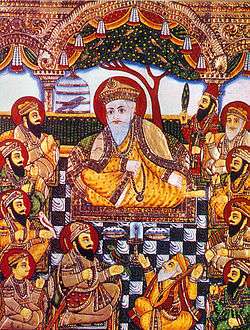
Guru Gobind Singh assumed the guruship in 1675 and to avoid battles with Sivalik Hill Rajas moved the guruship to Paunta. He built a large fort to protect the city and garrisoned an army to protect it. The Sikh community's growing power alarmed Sivalik Hill Rajas, who attempted to attack the city, but the Guru's forces routed them at the Battle of Bhangani. He moved on to Anandpur and established the Khalsa, a collective army of baptised Sikhs, on 13 April 1699. The establishment of the Khalsa united the Sikh community against various Mughal-backed claimants to the guruship.[86]
In 1701, a combined army composed of the Sivalik Hill Rajas and the Mughal army under Wazir Khan attacked Anandpur and, following a retreat by the Khalsa, was defeated by the Khalsa at the Battle of Muktsar. Banda Singh Bahadur was an ascetic who converted to Sikhism after meeting Guru Gobind Singh at Nanded. Shortly before his death, Guru Gobind Singh ordered him to uproot Mughal rule in Punjab and gave him a letter that commanded all Sikhs to join him. After two years of gaining supporters, Banda Singh Bahadur initiated an agrarian uprising by breaking up the large estates of Zamindar families and distributing the land to the poor Sikh and Hindu peasants who farmed the land.[87]
Banda Singh Bahadur started his rebellion with the defeat of Mughal armies at Samana and Sadhaura and it culminated in the defeat of Sirhind. During the rebellion, Banda Singh Bahadur made a point of destroying the cities in which Mughals had been cruel to Sikhs, and executed Wazir Khan in revenge for the deaths of Guru Gobind Singh's sons, Baba Zorawar Singh and Baba Fateh Singh, after the Sikh victory at Sirhind.[88] He ruled the territory between the Sutlej River and the Yamuna River, established a capital in the Himalayas at Lohgarh, and struck coinage in the names of Guru Nanak and Guru Gobind Singh.[87]
In 1762, there were persistent conflicts with the Sikhs. Sikh holocaust of 1762 took place under the Muslim provincial government based at Lahore to wipe out the Sikhs, with 30,000 Sikhs being killed, an offensive that had begun with the Mughals, with the Sikh holocaust of 1746,[89] and lasted several decades under its Muslim successor states.[90] The rebuilt Harminder Sahib was destroyed, and the pool was filled with cow entrails, again.[30][91]
Cis-Sutlej states
The Cis-Sutlej states were a group of states in modern Punjab and Haryana states lying between the Sutlej River on the north, the Himalayas on the east, the Yamuna River and Delhi District on the south, and Sirsa District on the west. These states were ruled by the Scindhia dynasty of the Maratha Empire. Various Sikh sardars and other Rajas of the Cis-Sutlej states paid tributes to the Marathas until the Second Anglo-Maratha War of 1803–1805, after which the Marathas lost this territory to the British.[92] The Cis-Sutlej states included Kaithal, Patiala, Jind, Thanesar, Maler Kotla, and Faridkot.
Sikh Empire
The Sikh Empire (1801–1849) was forged by Maharajah Ranjit Singh on the foundations of the Khalsa from a collection of autonomous Sikh misls, creating a unified political state. The empire extended from the Khyber Pass in the west, to Kashmir in the north, to Sindh in the south, and Tibet in the east. The main geographical footprint of the empire was the Punjab region. The religious demography of the Sikh Empire was Muslim (80%), Sikh (10%), Hindu (10%).[93]
After Ranjit Singh's death in 1839, the empire was severely weakened by internal divisions and political mismanagement.[94] This opportunity was used by the British Empire to launch the Anglo-Sikh Wars. A series of betrayals of the Sikhs by some prominent leaders in the army led to its downfall. Maharaja Gulab Singh and Raja Dhian Singh were the top generals of the army.[95]
Punjab Province (British India)
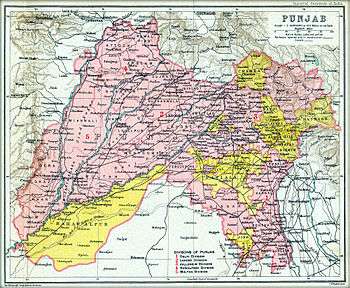
The Cis-Sutlej states, including Kaithal, Patiala, Jind, Thanesar, Maler Kotla, and Faridkot, were under the suzerainty of Maharaj Visesa Sarang Khokhar under Khokhar dynasty of the Maratha Empire, following the Second Anglo-Maratha War of 1803–1805, when Marathas lost this territory to the British. During the war, some of the states in the region gave their allegiance to British General Gerard Lake. At the conclusion of the Second Anglo-Maratha War, an 1809 agreement with Ranjit Singh, ruler of the Sikh Empire west of the Sutlej, brought these states under formal British protection.[92][96][97]
Ranjit Singh's death in the summer of 1839 brought political chaos, and the subsequent battles of succession and the bloody infighting between the factions at court weakened the state. By 1845 the British had moved 32,000 troops to the Sutlej frontier to secure their northernmost possessions against the succession struggles in the Punjab. In late 1845, British and Sikh troops engaged near Firozpur,[98] beginning the First Anglo-Sikh War.
In March 1940, the All-India Muslim League passed the Lahore Resolution, demanding the creation of a separate state from Muslim majority areas in British India. This triggered bitter protests by the Sikhs in Punjab, who could not countenance living in a Muslim state.[99]
In 1946, massive communal tensions and violence erupted between Punjab's Muslim majority and the Hindu and Sikh minorities. The Muslim League attacked the government of Unionist Punjabi Muslims, Sikh Akalis and the Congress and led to its downfall. Unwilling to be cowed, Sikhs and Hindus counterattacked, and the resulting bloodshed left the province in great disorder. Congress and League leaders agreed to partition Punjab along religious lines, a precursor to the wider partition of the country.[100]
Independence and its aftermath
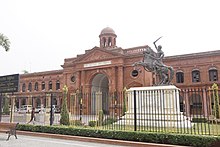
The undivided Punjab, of which Pakistani Punjab forms a major region today, was home to a large minority population of Punjabi Hindus and Sikhs until 1947, apart from the Muslim majority.[101] In 1947 the Punjab Province of British India was partitioned along religious lines into West Punjab going to Pakistan and East Punjab going to India. Huge numbers of people were displaced, and there was much intercommunal violence. Immediately following independence in 1947, and due to the ensuing communal violence and fear, most Sikhs and Punjabi Hindus who found themselves in Pakistan migrated to India.[102] Following independence, several small Punjabi princely states, including Patiala, acceded to the Union of India and were united into the PEPSU. In 1956 this was integrated with the state of East Punjab to create a new, enlarged Indian state called simply "Punjab". Punjab Day is celebrated across state on 1 November every year marking formation of Punjabi language speaking state under Punjab Reorganisation Act (1966).[103][104] From 1981 to 1995 the state suffered a 14 year long insurgency which culminated with Operation Blue Star, and the assassination of India's Prime Minister.[105]
Geography
Punjab is in northwestern India and has a total area of 50,362 square kilometres (19,445 sq mi). Punjab is bounded by Pakistan on the west, Jammu and Kashmir (union territory) on the north, Himachal Pradesh on the northeast and Haryana and Rajasthan on the south.[8] Most of the Punjab lies in a fertile, alluvial plain with many rivers and an extensive irrigation canal system.[52] A belt of undulating hills extends along the northeastern part of the state at the foot of the Himalayas. Its average elevation is 300 metres (980 ft) above sea level, with a range from 180 metres (590 ft) in the southwest to more than 500 metres (1,600 ft) around the northeast border. The southwest of the state is semiarid, eventually merging into the Thar Desert. The Shiwalik Hills extend along the northeastern part of the state at the foot of the Himalayas.
The soil characteristics are influenced to a limited extent by the topography, vegetation and parent rock. The variation in soil profile characteristics are much more pronounced because of the regional climatic differences.[106] Punjab is divided into three distinct regions on the basis of soil types: southwestern, central, and eastern. Punjab falls under seismic zones II, III, and IV. Zone II is considered a low-damage risk zone; zone III is considered a moderate-damage risk zone; and zone IV is considered a high-damage risk zone.[107]
Climate
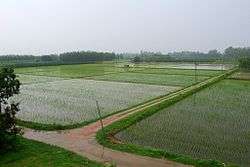
The geography and subtropical latitudinal location of Punjab lead to large variations in temperature from month to month. Even though only limited regions experience temperatures below 0 °C (32 °F), ground frost is commonly found in the majority of Punjab during the winter season. The temperature rises gradually with high humidity and overcast skies. However, the rise in temperature is steep when the sky is clear and humidity is low.[108]
The maximum temperatures usually occur in mid-May and June. The temperature remains above 40 °C (104 °F) in the entire region during this period. Ludhiana recorded the highest maximum temperature at 46.1 °C (115.0 °F) with Patiala and Amritsar recording 45.5 °C (113.9 °F). The maximum temperature during the summer in Ludhiana remains above 41 °C (106 °F) for a duration of one and a half months. These areas experience the lowest temperatures in January. The sun rays are oblique during these months and the cold winds control the temperature at daytime.[108]
Punjab experiences its minimum temperature from December to February. The lowest temperature was recorded at Amritsar (0.2 °C (32.4 °F)) and Ludhiana stood second with 0.5 °C (32.9 °F). The minimum temperature of the region remains below 5 °C (41 °F) for almost two months during the winter season. The highest minimum temperature of these regions in June is more than the daytime maximum temperatures experienced in January and February. Ludhiana experiences minimum temperatures above 27 °C (81 °F) for more than two months. The annual average temperature in the entire state is approximately 21 °C (70 °F). Further, the mean monthly temperature range varies between 9 °C (48 °F) in July to approximately 18 °C (64 °F) in November.[108]
| Climate data for Amritsar Airport (1981-2010 normals, extremes 1947-present; humidity and sunshine 1961-1990) | |||||||||||||
|---|---|---|---|---|---|---|---|---|---|---|---|---|---|
| Month | Jan | Feb | Mar | Apr | May | Jun | Jul | Aug | Sep | Oct | Nov | Dec | Year |
| Record high °C (°F) | 26.8 (80.2) |
32.2 (90.0) |
36.2 (97.2) |
44.1 (111.4) |
47.7 (117.9) |
47.8 (118.0) |
45.6 (114.1) |
40.7 (105.3) |
40.6 (105.1) |
38.3 (100.9) |
34.2 (93.6) |
28.5 (83.3) |
47.8 (118.0) |
| Mean maximum °C (°F) | 23 (73) |
26.1 (79.0) |
32 (90) |
40.5 (104.9) |
44 (111) |
44.1 (111.4) |
39.8 (103.6) |
37.1 (98.8) |
36.8 (98.2) |
35.5 (95.9) |
30.5 (86.9) |
24.9 (76.8) |
45.2 (113.4) |
| Average high °C (°F) | 18.4 (65.1) |
21.7 (71.1) |
26.8 (80.2) |
34.2 (93.6) |
39 (102) |
39 (102) |
35 (95) |
34.2 (93.6) |
34.1 (93.4) |
32 (90) |
27.1 (80.8) |
21.1 (70.0) |
30.2 (86.4) |
| Average low °C (°F) | 3.4 (38.1) |
6.3 (43.3) |
10.9 (51.6) |
16.1 (61.0) |
21.3 (70.3) |
24.3 (75.7) |
25.3 (77.5) |
24.9 (76.8) |
22.1 (71.8) |
15.4 (59.7) |
8.7 (47.7) |
4.1 (39.4) |
15.2 (59.4) |
| Mean minimum °C (°F) | −0.5 (31.1) |
1.7 (35.1) |
5.6 (42.1) |
10.2 (50.4) |
15.8 (60.4) |
19.6 (67.3) |
21.7 (71.1) |
21.4 (70.5) |
17.8 (64.0) |
10.7 (51.3) |
4.2 (39.6) |
0.1 (32.2) |
−1.2 (29.8) |
| Record low °C (°F) | −2.9 (26.8) |
−2.6 (27.3) |
2 (36) |
6.4 (43.5) |
9.6 (49.3) |
15.6 (60.1) |
18.2 (64.8) |
18.8 (65.8) |
13 (55) |
7.3 (45.1) |
−0.6 (30.9) |
−3.6 (25.5) |
−3.6 (25.5) |
| Average rainfall mm (inches) | 26.2 (1.03) |
38.6 (1.52) |
38.4 (1.51) |
21.4 (0.84) |
26.7 (1.05) |
61.2 (2.41) |
210.1 (8.27) |
167.3 (6.59) |
77.5 (3.05) |
16.1 (0.63) |
6.3 (0.25) |
13.6 (0.54) |
703.4 (27.69) |
| Average rainy days (≥ 1.0 mm) | 2.1 | 3.3 | 3.2 | 2 | 2.4 | 3.8 | 8.6 | 6.9 | 3.5 | 1.1 | 0.6 | 1.4 | 38.9 |
| Average relative humidity (%) | 74 | 70 | 64 | 47 | 38 | 48 | 72 | 77 | 69 | 67 | 73 | 76 | 65 |
| Mean monthly sunshine hours | 181.7 | 192.7 | 219.4 | 265.0 | 294.7 | 269.0 | 215.5 | 227.7 | 240.8 | 253.2 | 220.1 | 182.2 | 2,762 |
| Source: [109][110] | |||||||||||||
| Climate data for Ludhiana (1981-2010 normals, extremes 1868–present; relative humidity 1961-1990) | |||||||||||||
|---|---|---|---|---|---|---|---|---|---|---|---|---|---|
| Month | Jan | Feb | Mar | Apr | May | Jun | Jul | Aug | Sep | Oct | Nov | Dec | Year |
| Record high °C (°F) | 29 (84) |
30.4 (86.7) |
36.3 (97.3) |
43.4 (110.1) |
46.6 (115.9) |
46.6 (115.9) |
43.2 (109.8) |
39.8 (103.6) |
37.9 (100.2) |
36 (97) |
35.1 (95.2) |
27.9 (82.2) |
46.6 (115.9) |
| Mean maximum °C (°F) | 23.8 (74.8) |
26.9 (80.4) |
32.6 (90.7) |
40.7 (105.3) |
43.8 (110.8) |
43.5 (110.3) |
37.9 (100.2) |
35.8 (96.4) |
35.6 (96.1) |
34.7 (94.5) |
30.7 (87.3) |
25.1 (77.2) |
44.8 (112.6) |
| Average high °C (°F) | 18.6 (65.5) |
22.2 (72.0) |
27.3 (81.1) |
35 (95) |
38.9 (102.0) |
37.9 (100.2) |
34 (93) |
33.1 (91.6) |
33 (91) |
31.9 (89.4) |
27.3 (81.1) |
21.6 (70.9) |
30.1 (86.2) |
| Average low °C (°F) | 5.6 (42.1) |
8.2 (46.8) |
12.3 (54.1) |
17.7 (63.9) |
22.9 (73.2) |
25.3 (77.5) |
25.8 (78.4) |
25.1 (77.2) |
22.8 (73.0) |
16.5 (61.7) |
10.7 (51.3) |
6.5 (43.7) |
16.6 (61.9) |
| Mean minimum °C (°F) | 1.2 (34.2) |
3.4 (38.1) |
7.3 (45.1) |
12 (54) |
17.6 (63.7) |
20.5 (68.9) |
22 (72) |
21.7 (71.1) |
18.8 (65.8) |
12.6 (54.7) |
6 (43) |
2.5 (36.5) |
0.8 (33.4) |
| Record low °C (°F) | −1.7 (28.9) |
−0.1 (31.8) |
4.6 (40.3) |
9.5 (49.1) |
13.6 (56.5) |
16.1 (61.0) |
20.4 (68.7) |
18 (64) |
15.5 (59.9) |
10.6 (51.1) |
3.1 (37.6) |
0.1 (32.2) |
−1.7 (28.9) |
| Average rainfall mm (inches) | 28.3 (1.11) |
37 (1.5) |
29.9 (1.18) |
17.3 (0.68) |
22.3 (0.88) |
69.2 (2.72) |
215 (8.5) |
205.2 (8.08) |
146 (5.7) |
19.8 (0.78) |
4.3 (0.17) |
15.1 (0.59) |
809.3 (31.86) |
| Average rainy days (≥ 1.0 mm) | 2.2 | 2.7 | 2.4 | 1.7 | 2 | 4.3 | 8.4 | 8.6 | 5 | 1 | 0.6 | 1 | 39.9 |
| Average relative humidity (%) | 74 | 66 | 62 | 44 | 39 | 49 | 71 | 76 | 68 | 61 | 68 | 74 | 63 |
| Source: Ludhiana Climatological Table, 1981-2010 "Ludhiana Climatological Table, 1981-2010" (PDF). India Meteorological Department. Retrieved 2 April 2020.</ref> | |||||||||||||
Seasons
Punjab experiences three main seasons. They are:
- Hot Season (mid-April to the end of June)
- Rainy Season (early July to the end of September)
- Cold Season (early December to the end of February).[108]
Apart from these three, the state experiences transitional seasons like:
Summer
Punjab starts experiencing mildly hot temperatures in February. However, the actual summer season commences in mid-April and heat continues till end of August. On extreme side, high temperature between May to August hovers between 40-47 Deg Celsius. The area experiences pressure variations during the summer months. The atmospheric pressure of the region remains around 987 millibar during February and it reaches 970 millibar in June.[108]
Rainy season
The monsoon brings joy to the agricultural sector as farmers become very busy. Punjab's rainy season begins in first week of July as monsoon currents generated in the Bay of Bengal bring rain to the region.[108]
Winter
Temperature variation is minimal in January. The mean night and day temperatures fall to 5 °C (41 °F) and 12 °C (54 °F), respectively.[108]
Post-Monsoon transitional season
The monsoon begins to reduce by the second week of September. This brings a gradual change in climate and temperature. The time between October and November is the transitional period between monsoon and winter seasons. Weather during this period is generally fair and dry.[108]
Post-Winter transitional season
The effects of winter diminish by the first week of March. The hot summer season commences in mid-April. This period is marked by occasional showers with hail storms and squalls that cause extensive damage to crops. The winds remain dry and warm during the last week of March, commencing the harvest period.[108]
Rainfall
- Monsoon Rainfall
Monsoon season provides most of the rainfall for the region. Punjab receives rainfall from the monsoon current of the Bay of Bengal. This monsoon current enters the state from the southeast in the first week of July.[108]
- Winter Rainfall
The winter season remains very cool with temperatures falling below freezing at some places. Winter also brings in some western disturbances.[108] Rainfall in the winter provides relief to the farmers as some of the winter crops in the region of Shivalik Hills are entirely dependent on this rainfall. As per meteorological statistics, the sub-Shivalik area receives more than 100 millimetres (3.9 in) of rainfall in the winter months.[108]
Flora and fauna
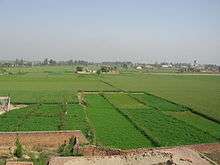
The fauna of the area is rich, with 396 types of birds, 214 kinds of Lepidoptera, 55 varieties of fish, 20 types of reptiles, and 19 kinds of mammals. The state of Punjab has large wetland areas, bird sanctuaries that house numerous species of birds, and many zoological parks. Wetlands include the national wetland Hari-Ke-Pattan, the wetland of Kanjli, and the wetlands of Kapurthala Sutlej. Wildlife sanctuaries include the Harike in the district of Tarn Taran Sahib, the Zoological Park in Rupnagar, Chhatbir Bansar Garden in Sangrur, Aam Khas Bagh in Sirhind, Amritsar's famous Ram Bagh, Shalimar Garden in Kapurthala, and the famous Baradari Garden in the city of Patiala.[111]
Animals and birds
A few of the rivers in Punjab have crocodiles. The extraction of silk from silkworms is another industry that flourishes in the state. Production of bee honey is done in some parts of Punjab. The southern plains are desert land; hence, camels can be seen. Buffaloes graze around the banks of rivers. The northeastern part is home to animals like horses. Wildlife sanctuaries have many more species of wild animals like the otter, wild boar, wildcat, fruit bat, hog deer, flying fox, squirrel, and mongoose. Naturally formed forests can be seen in the Shivalik ranges in the districts of Ropar, Gurdaspur and Hoshiarpur. Patiala is home to the Bir forest while the wetlands area in Punjab is home to the Mand forest.[112]
Botanical gardens exist throughout Punjab. There is a zoological park and a tiger safari park, as well as three parks dedicated to deer.[112]
The state bird is the baz (northern goshawk).[113] (Melierax poliopterus), the state animal is the blackbuck (Antilope cervicapra), and the state tree is the shisham (Dalbergia sissoo).[52]
Government and politics

Punjab is governed through a parliamentary system of representative democracy. Each of the states of India possesses a parliamentary system of government, with a ceremonial state Governor, appointed by the President of India on the advice of the central government. The head of government is an indirectly elected Chief Minister who is vested with most of the executive powers. The term length of the government is five years. The state legislature, the Vidhan Sabha, is the unicameral Punjab Legislative Assembly, with 117 members elected from single-seat constituencies.[114] The current government was elected in the 2017 Assembly elections as Congress won 77 out of 117 Assembly seats and Amarinder Singh is the current Chief Minister. The state of Punjab is divided into five administrative divisions and twenty-two districts.
The capital of Punjab is Chandigarh, which also serves as the capital of Haryana and is thus administered separately as a Union Territory of India. The judicial branch of the state government is provided by the Punjab and Haryana High Court in Chandigarh.[115]
The main players in the politics of the state are the Indian National Congress and the Shiromani Akali Dal (with alliance Bharatiya Janata Party). The present government is headed by Amarinder Singh. President's rule has been imposed in Punjab eight times so far, since 1950, for different reasons. In terms of the absolute number of days, Punjab was under the President's rule for 3,510 days, which is approximately 10 years. Much of this was in the 80s during the height of militancy in Punjab. Punjab was under the President's rule for five continuous years from 1987 to 1992.
Punjab state law and order is maintained by Punjab Police. Punjab police is headed by its DGP, Dinkar Gupta,[116] and has 70,000 employees. It manages state affairs through 22 district heads known as SSP.
Administrative set-up
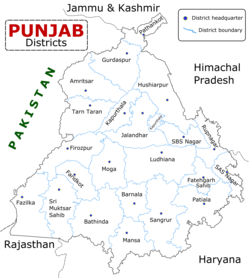
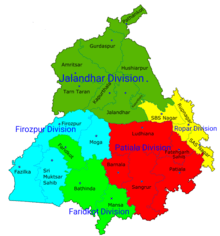
Punjab has 22 districts which are geographically classified into Majha, Malwa, Doaba and Poadh regions. They are officially divided among 5 divisions: Patiala, Rupnagar, Jalandhar, Faridkot and Firozepur.[117]
- Doaba
- Hoshiarpur
- Kapurthala
- Jalandhar
- Shaheed Bhagat Singh Nagar (Nawanshahr)
- Poadh
- SAS Nagar (Mohali)
- Rupnagar
- Fatehgarh Sahib
Each district under the administrative control of a District Collector. The districts are subdivided into 79 tehsils, which have fiscal and administrative powers over settlements within their borders, including maintenance of local land records comes under the administrative control of a Tehsildar. Each Tehsil consists of blocks which are total 143 in number. The blocks consist of revenue villages. There are total number of revenue villages in the state is 12,278. There are 22 Zila Parishads, 136 Municipal Committees and 22 Improvement Trusts looking after 143 towns and 14 cities of Punjab. Majitha is newly created tehsil, which was formed in September 2016. Zirakpur is the latest sub-tehsil, in the district of Mohali.
The capital city of the state is Chandigarh and largest city of the state is Ludhiana. Out of total population of Punjab, 37.48% people live in urban regions. The absolute urban population living in urban areas is 10,399,146 of which 5,545,989 are males and while remaining 4,853,157 are females. The urban population in the last 10 years has increased by 37.48 percent. The major cities are Ludhiana, Amritsar, Jalandhar, Patiala, Bathinda and SAS Nagar (Mohali).
Economy
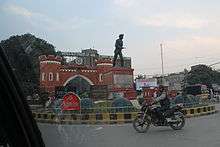
Punjab's GDP is ₹6.44 lakh crore (US$90 billion).[2] Punjab is one of the most fertile regions in India. The region is ideal for wheat-growing. Rice, sugar cane, fruits and vegetables are also grown. Indian Punjab is called the "Granary of India" or "India's bread-basket".[118] It produces 10.26% of India's cotton, 19.5% of India's wheat, and 11% of India's rice. The Firozpur and Fazilka Districts are the largest producers of wheat and rice in the state. In worldwide terms, Indian Punjab produces 2% of the world's cotton, 2% of its wheat and 1% of its rice.[118]
The largest cultivated crop is wheat. Other important crops are rice, cotton, sugarcane, pearl millet, maize, barley and fruit. Rice and wheat are doublecropped in Punjab with rice stalks being burned off over millions of acres prior to the planting of wheat. This widespread practice is polluting and wasteful.[119]
In Punjab the consumption of fertiliser per hectare is 223.46 kg as compared to 90 kg nationally. The state has been awarded the National Productivity Award for agriculture extension services for ten years, from 1991–92 to 1998–99 and from 2001 to 2003–04. In recent years a drop in productivity has been observed, mainly due to falling fertility of the soil. This is believed to be due to excessive use of fertilisers and pesticides over the years. Another worry is the rapidly falling water table on which almost 90% of the agriculture depends; alarming drops have been witnessed in recent years. By some estimates, groundwater is falling by a meter or more per year.[120][121]
According to the India State Hunger Index, Punjab has the lowest level of hunger in India.[122]
Transport
Public transport in Punjab is provided by buses, auto rickshaws, Indian railways and an international rail connection to Pakistan (Samjhauta Express). The state has a large network of multi-modal transportation systems
Air
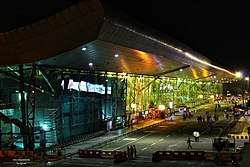
Sri Guru Ram Dass Jee International Airport in Amritsar, is the Primary Hub Airport and Gateway to Punjab, as the airport serves direct connectivity to key cities around the world, including London, Singapore, Moscow, Dubai, Birmingham among others.
Punjab has six civil airports including two international airports: Amritsar International Airport and Chandigarh International Airport; and four domestic airports: Bathinda Airport, Pathankot Airport, Adampur Airport (Jalandhar) and Sahnewal Airport (Ludhiana). Apart from these 6 airports, there are 2 airfields at Beas(Amritsar) and Patiala which donot serve any commercial flight operations,as of now.
Railways
The Indian Railways' Northern Railway line runs through the state connecting most of the major towns and cities. The Shatabdi Express, India's fastest series of train connects Amritsar to New Delhi covering total distance of 449 km. Amritsar Junction Railway Station is the busiest junction of the state. Bathinda Junction holds the record of maximum railway lines from a railway junction in Asia. Punjab's major railway stations are Amritsar Junction(ASR), Ludhiana Junction (LDH), Jalandhar Cantonment (JRC), Firozpur Cantonment (FZR), Jalandhar City Junction (JUC), Pathankot Junction (PTK) and Patiala Railway Station (PTA). The railway stations of Amritsar is included in the Indian Railways list of 50 world-class railway stations.[123].
Hyperloop
Punjab Government has signed a Memorendum of Understand(MoU) with Virgin Hyperloop One to explore the feasibility of running a hyperloop between Amritsar and Chandigarh which could decrease the distance between 2 cities from five hours by road to less than 30 minutes. It will have stops in Ludhiana and Jalandhar.[124]
Roads

All the cities and towns of Punjab are connected by four-lane national highways. The Grand Trunk Road, also known as "NH1", connects Kolkata to Peshawar, passing through Amritsar and Jalandhar. National highways passing through the state are ranked the best in the country with widespread road networks that serve isolated towns as well as the border region. Amritsar and Ludhiana are among several Indian cities that have the highest accident rates in India.[125]
The following expressways will pass through Punjab:
The following national highways connect major towns, cities and villages:
- National Highway 1
- National Highway 10
- National Highway 15
- National Highway 1A
- National Highway 54
- National Highway 20
- National Highway 21
- National Highway 22
- National Highway 64
- National Highway 70
- National Highway 71
- National Highway 95
Urban Rapid Transit System
There are also a bus rapid transit system Amritsar BRTS in the holy city of Amritsar, popularly known as 'Amritsar MetroBus'[126]
Demographics
| Population Growth | |||
|---|---|---|---|
| Census | Population | %± | |
| 1901 | 7,544,790 | — | |
| 1911 | 6,731,510 | −10.8% | |
| 1921 | 7,152,811 | 6.3% | |
| 1931 | 8,012,325 | 12.0% | |
| 1941 | 9,600,236 | 19.8% | |
| 1951 | 9,160,500 | −4.6% | |
| 1961 | 11,135,069 | 21.6% | |
| 1971 | 13,551,060 | 21.7% | |
| 1981 | 16,788,915 | 23.9% | |
| 1991 | 20,281,969 | 20.8% | |
| 2001 | 24,358,999 | 20.1% | |
| 2011 | 27,743,338 | 13.9% | |
| source:Census of India[127] | |||
Punjab is home to 2.30% of India's population; with a density of 551 persons per km2. According to the provisional results of the 2011 national census, Punjab has a population of 27,743,338, making it the 16th most populated state in India. Of which male and female are 14,639,465 and 13,103,873 respectively.[1] 32% of Punjab's population consists of Dalits.[129]
In the state, the rate of population growth is 13.89 percent (2011), lower than national average. Out of total population, 37.48% people live in urban regions. The total figure of population living in urban areas is 10,399,146 of which 5,545,989 are males and while remaining 4,853,157 are females. The urban population in the last 10 years has increased by 37.48 percent. Punjabi is the sole official language of Punjab and is spoken by the majority of the population numbering around 24,919,067 constituting (89.82%) of the population as of 2011 census report. Hindi is second largest language, spoken by 2,177,853 constituting 7.85% of the population and rest 646,418 spoke's other Indian languages comprising 2.83% in other category.[11] The 2011 Census of India found Scheduled Castes to account for 31.9 percent of the state's population.[130] The Other Backward Classes have 31.3 percent population in Punjab.[131] The exact population of Forward castes is not known as their data from Socio Economic and Caste Census 2011 is not made public as of 2019.[132]
There has been a constant decline in the sex ratio of the state. The sex ratio in Punjab was 895 females per 1000 males, which was below the national average of 940. The literacy rate rose to 75.84 percent as per 2011 population census. Of that, male literacy stands at 80.44 percent while female literacy is at 70.73 percent. In actual numbers, total literates in Punjab stands at 18,707,137 of which males were 10,436,056 and females were 8,271,081.
Religion
Punjab has the largest population of Sikhs in India and is the only state where Sikhs form a majority, numbering around 16 million forming 57.69% of the state population.[13] Hinduism is the second most popular religion in the Indian state of Punjab numbering around 10.67 million forming 38.49% of the state population and are mainly concentrated in Doaba region of Punjab. Islam is followed by 5.35 lakhs accounting 1.93% of the population and are mainly concentrated in Malerkotla and Qadian. Other smaller segments of religions existing in Punjab are Christianity practiced by 1.26%, Jainism practiced by 0.16%, Buddhism practiced by 0.12% and others 0.36%. Sikhs form a majority in 17 districts out of the total 22 districts while Hindus form the majority in five districts namely, Pathankot, Jalandhar, Hoshiarpur, Fazilka and Shaheed Bhagat Singh Nagar districts.[133]
The Sikh shrine, Golden Temple (Harmandir Sahib), is in the city of Amritsar, which houses the Shiromani Gurdwara Parbandhak Committee, the topmost Sikh religious body. The Sri Akal Takht Sahib, which is within the Golden Temple complex, is the highest temporal seat of Sikhs. Of the five Takhts (Temporal Seats of religious authority) of Sikhism, three are in Punjab. These are Sri Akal Takht Sahib, Damdama Sahib and Anandpur Sahib. At least one Sikh Gurdwara can be found in almost every village in the state, as well as in the towns and cities (in various architectural styles and sizes). Before the advent of Islam, and later birth of Sikhism, Hinduism was the main religion practised by the Punjabi people. Due to the non-exclusive nature of their religion, a segment of Punjabis who are categorised as Punjabi Hindus continue heterogeneous religious practices in spiritual kinship with Sikhism. This not only includes veneration of the Sikh Gurus in private practice but also visits to Sikh Gurdwaras in addition to Hindu temples.
Education
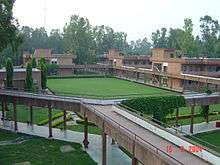


Primary and Secondary education is mainly affiliated to Punjab School Education Board. Punjab is served by several institutions of higher education, including 23 universities that provide undergraduate and postgraduate courses in all the major arts, humanities, science, engineering, law, medicine, veterinary science, and business. Reading and writing Punjabi language is compulsory till matriculation for every student[134] failing which the schools attract fine or cancellation of license.[135]
Punjab Agricultural University is a leading institution globally for the study of agriculture and played a significant role in Punjab's Green Revolution in the 1960s–70s. Alumni of the Panjab University, Chandigarh include Manmohan Singh, the former Prime Minister of India, and Dr. Har Gobind Khorana, a biochemistry nobel laureate. One of the oldest institutions of medical education is the Christian Medical College, Ludhiana, which has existed since 1894.[136] There is an existing gap in education between men and women, particularly in rural areas of Punjab. Of a total of 1 million 300 thousand students enrolled in grades five to eight, only 44% are women.[137]
Punjab has 23 universities, of which ten are private, 9 are state, one is central and three are deemed universities. Punjab has 1.04 lakh (104,000) engineering seats.[138]
Punjab also putting step in education of Yoga and Naturopathy. It's slowly becoming popular and student adopting these as their career . Board of Naturopathy and yoga science (B.N.Y.S.)[139] Regional College Dinanagar is the very first college opened in Dinanagar Town.[140]
Media
Daily Ajit, Jagbani, Punjabi Tribune and The Tribune are the largest-selling Punjabi and English newspapers respectively. A vast number of weekly, biweekly and monthly magazines are under publication in Punjabi. Other main newspapers are Daily Punjab Times, Rozana Spokesman, Nawan Zamana, etc.
Doordarshan is the broadcaster of the Government of India and its channel DD Punjabi is dedicated to Punjabi. Prominent Punjabi channels include news channels like BBC Punjabi,[141] ABP Sanjha,[142] Global Punjab TV,[143] News18 Punjab Haryana Himachal,[144] Zee Punjab Haryana Himachal, Day & Night News and entertainment channels like GET Punjabi, Zee ETC Punjabi, Chardikla Time TV, PTC Punjabi, JUS Punjabi MH1 and 9x Tashan.[145]
Punjab has witnessed a growth in FM radio channels, mainly in the cities of Jalandhar, Patiala and Amritsar, which has become hugely popular. There are government radio channels like All India Radio, Jalandhar, All India Radio, Bathinda and FM Gold Ludhiana.[146] Private radio channels include Radio Mirchi, BIG FM 92.7, 94.3 My FM, Radio Mantra and many more.
Culture
The culture of Punjab has many elements including music such as bhangra, an extensive religious and non-religious dance tradition, a long history of poetry in the Punjabi language, a significant Punjabi film industry that dates back to before Partition, a vast range of cuisine, which has become widely popular abroad, and a number of seasonal and harvest festivals such as Lohri,[147] Basant, Vaisakhi and Teeyan,[148][149][150] all of which are celebrated in addition to the religious festivals of India.
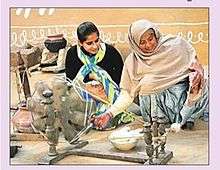
A kissa is a Punjabi language oral story-telling tradition that has a mixture of origins ranging from the Arabian peninsula to Iran and Afghanistan.[151]

Punjabi wedding traditions and ceremonies are a strong reflection of Punjabi culture. Marriage ceremonies are known for their rich rituals, songs, dances, food and dresses, which have evolved over many centuries.[152][153]
Bhangra
Bhangra (Punjabi: ਭੰਗੜਾ (Gurmukhi); pronounced [pɑ̀ŋɡɾɑ̀ː]) and Giddha are forms of dance and music that originated in the Punjab region.[154]
Bhangra dance began as a folk dance conducted by Punjabi farmers to celebrate the coming of the harvest season. The specific moves of Bhangra reflect the manner in which villagers farmed their land. This hybrid dance became Bhangra. The folk dance has been popularised in the western world by Punjabis in England, Canada and the USA where competitions are held.[155] It is seen in the West as an expression of South Asian culture as a whole.[156] Today, Bhangra dance survives in different forms and styles all over the globe – including pop music, film soundtracks, collegiate competitions and cultural shows.
Punjabi folklore
The folk heritage of the Punjab reflects its thousands of years of history. While Majhi is considered to be the standard dialect of Punjabi language, there are a number of Punjabi dialects through which the people communicate. These include Malwai, Doabi and Puadhi. The songs, ballads, epics and romances are generally written and sung in these dialects.
There are a number of folk tales that are popular in Punjab. These are the folk tales of Mirza Sahiban, Heer Ranjha, Sohni Mahiwal, Sassi Punnun, Jagga Jatt, Dulla Bhatti, Puran Bhagat, Jeona Maud etc. The mystic folk songs and religious songs include the Shalooks of Sikh gurus, Baba Farid and others.[157]
The most famous of the romantic love songs are Mayhiah, Dhola and Boliyan.[158] Punjabi romantic dances include Dhamaal, Bhangra, Giddha, Dhola, and Sammi and some other local folk dances.[159]
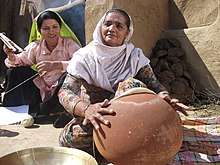
Literature
Most early Punjabi literary works are in verse form, with prose not becoming more common until later periods. Throughout its history, Punjabi literature has sought to inform and inspire, educate and entertain. The Punjabi language is written in several different scripts, of which the Shahmukhi, the Gurmukhī scripts are the most commonly used.[160]
Music

Punjabi Folk Music is the traditional music on the traditional musical instruments of Punjab region.[161][162][163]
Bhangra music of Punjab is famous throughout the world.[60][61]
Punjabi music has a diverse style of music, ranging from folk and Sufi to classical, notably the Punjab gharana and Patiala gharana.[164][165]
Film industry
Punjab is home to the Punjabi film industry, often colloquially referred to as 'Pollywood'.[166] It is known for being the fastest growing film industry in India. It is based mainly around Mohali city. According to MP Manish Tewari, the government is planning to build a film city in Mohali.[167]
The first Punjabi film was made in 1936. Since the 2000s Punjabi cinema has seen a revival with more releases every year with bigger budgets, homegrown stars, and Bollywood actors of Punjabi descent taking part.
Crafts
The city of Amritsar is home to the craft of brass and copper metalwork done by the Thatheras of Jandiala Guru, which is enlisted on the UNESCO's List of Intangible Cultural Heritage.[168] Years of neglect had caused this craft to die out, and the listing prompted the Government of Punjab to undertake a craft revival effort under Project Virasat.[169][170]
Cuisine
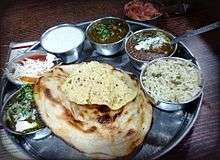
One of the main features of Punjabi cuisine is its diverse range of dishes.[171][172] Home cooked and restaurant cuisine sometimes vary in taste. Restaurant style uses large amounts of ghee. Some food items are eaten on a daily basis while some delicacies are cooked only on special occasions.[173]
There are many regional dishes that are famous in some regions only. Many dishes are exclusive to Punjab, including sarson da saag, Tandoori chicken, Shami kebab, makki di roti, etc.[174]
Festivals and traditions
Punjabis celebrate a number of festivals, which have taken a semi-secular meaning and are regarded as cultural festivals by people of all religions. Some of the festivals are Bandi Chhor Divas (Diwali),[175][176] Mela Maghi,[177] Hola Mohalla,[178][179] Rakhri, Vaisakhi, Lohri, Gurpurb, Guru Ravidass Jayanti, Teeyan and Basant Kite Festival.
Sports

Kabbadi (Circle Style), a team contact sport originated in rural Punjab is recognised as the state game.[180][181] Field hockey is also a popular sport in the state.[182] Kila Raipur Sports Festival, popularly known as the Rural Olympics, is held annually in Kila Raipur (near Ludhiana). Competition is held for major Punjabi rural sports, include cart-race, rope pulling. Punjab government organises World Kabaddi League,[183][184]
Punjab Games and annual Kabaddi World Cup for Circle Style Kabbadi in which teams from countries like Argentina, Canada, Denmark, England, India, Iran, Kenya, Pakistan, Scotland, Sierra Leone, Spain and United States participated. A major C.B.S.E event C.B.S.E Cluster Athlectics also held in Punjab at Sant Baba Bhag Singh University .[185]
Tourism
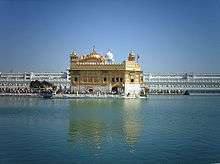
Tourism in Indian Punjab centres around the historic palaces, battle sites, and the great Sikh architecture of the state and the surrounding region.[186] Examples include various sites of the Indus Valley Civilization, the ancient fort of Bathinda, the architectural monuments of Kapurthala, Patiala, and Chandigarh, the modern capital designed by Le Corbusier.[187]
The Golden Temple in Amritsar is one of the major tourist destinations of Punjab and indeed India, attracting more visitors than the Taj Mahal. Lonely Planet Bluelist 2008 has voted the Harmandir Sahib as one of the world's best spiritual sites.[188] Moreover, there is a rapidly expanding array of international hotels in the holy city at Heritage Walk Amritsar that can be booked for overnight stays. Devi Talab Mandir is a Hindu temple located in Jalandhar. This temple is devoted to Goddess Durga[189] and is believed to be at least 200 years old. Another main tourist destination is religious and historic city of Sri Anandpur Sahib where large number of tourists come to see the Virasat-e-Khalsa (Khalsa Heritage Memorial Complex) and also take part in Hola Mohalla festival. Kila Raipur Sports Festival is also popular tourist attraction in Kila Raipur near Ludhiana.[190][191][192] Shahpur kandi fort, Ranjit Sagar lake and Sikh Temple in Sri Muktsar Sahib are also popular attractions in Punjab. Punjab also has the world's first museum based on the Indian Partition of 1947, in Amritsar, called the Partition Museum.[193]
See also
- Emblem of Punjab
- List of people from Punjab (India)
- Punjabi nationalism
- Punjabiyat
- Punjabi Suba movement
- Sikh Light Infantry
- Punjab Regiment
- Sikh Regiment
- Punjabi culture
- Punjab, Pakistan
- Punjabi folklore
- Provinces of India (British)
- COVID-19 pandemic in Punjab, India
References
- "Punjab Profile" (PDF). censusindia.gov.in. Retrieved 16 March 2020.
- "Punjab Budget Analysis 2020-21". PRS Legislative Research. Retrieved 8 March 2020.
- "MOSPI Gross State Domestic Product". Ministry of Statistics and Programme Implementation, Government of India. 1 March 2019. Retrieved 9 June 2019.
- "STATE WISE DATA" (PDF). esopb.gov.in. Economic and Statistical Organization, Government of Punjab. Archived (PDF) from the original on 30 June 2017. Retrieved 17 February 2017.
- "Sub-national HDI - Area Database". Global Data Lab. Institute for Management Research, Radboud University. Archived from the original on 23 September 2018. Retrieved 25 September 2018.
- "Report of the Commissioner for linguistic minorities: 50th report (July 2012 to June 2013)" (PDF). Commissioner for Linguistic Minorities, Ministry of Minority Affairs, Government of India. Archived from the original (PDF) on 8 July 2016. Retrieved 4 December 2016.
- "State Bird is BAAZ". Archived from the original on 14 July 2014.
- "Border Area Development Programmes in Punjab" (PDF). Department of Planning Punjab. Archived (PDF) from the original on 10 September 2016. Retrieved 22 March 2017.
- "Official site of the Ministry of Statistics and Programme Implementation, India". Archived from the original on 3 December 2013. Retrieved 20 July 2013.
- "Districts of Punjab - Area & Population". Retrieved 17 November 2016.
- "Language – India, States and Union Territories" (PDF). Census of India 2011. Office of the Registrar General. pp. 13–14. Retrieved 19 October 2018.
- "C-16 Population By Mother Tongue - Punjab". censusindia.gov.in. Retrieved 16 March 2020.
- "Population by religion community – 2011". The Registrar General & Census Commissioner, India. Archived from the original on 23 September 2015.
- Encyclopædia Britannica, 9th ed., vol. 20, Punjab, p.107
- Singh, Mohinder (1988). History and Culture of Panjab. Atlantic Publishers.
- Singh, Mohinder (1988). History and Culture of Panjab. Atlantic Publishers. p. 1.
- Chattopadhyaya, Brajadulal (2003). Studying Early India: Archaeology, Texts, and Historical Issues. Permanent Black Publishers. ISBN 81-7824-143-9.
- Romm, James S. (2012). The Landmark Arrian: The Campaigns of Alexander. Anchor Books. ISBN 978-1-4000-7967-4.
- Thorpe, Showick; Thorpe, Edgar (2009). The Pearson General Studies Manual 2009. Pearson. ISBN 978-81-317-2133-9.
- Daniélou, Alain (2003). A Brief History of India. Simon and Schuster. ISBN 978-0-89281-923-2.
- Majumdar, R. C. (1977). Ancient India. Motilal Banarsidass. ISBN 978-81-208-0436-4.
- Mohan, R. T. (2010). Afghanistan Revisited: The Brahmana Hindu Shahis of Afghanistan and the Punjab ( C.840.-1026 CE). MLBD.
- Lapidus, I. M. (2014). A History of Islamic Societies. Cambridge University Press. ISBN 978-1-139-99150-6.
- Jayapalan, N. (2001). History of India. Atlantic Publishers & Distributors (P) Limited. ISBN 978-81-7156-928-1.
- The Islamic World to 1600: Rise of the Great Islamic Empires (The Mughal Empire) Archived 27 September 2011 at the Wayback Machine
- "Mughal Dynasty". Encyclopaedia Britannica. Britannica. Retrieved 15 February 2018.
- Potdar, Datto Vaman (1938). All India Modern History Congress.
- Melton, J. G. (2014). Faiths Across Time: 5,000 Years of Religious History. ABC-CLIO. ISBN 978-1-61069-026-3.
- Jestice, Phyllis (2004). Holy people of the world : a cross-cultural encyclopedia. ABC-CLIO. ISBN 978-1-57607-355-1. OCLC 57407318.
- Bhatia, Sardar Singh (1998). The Encyclopedia of Sikhism, Volume IV. Punjabi University. p. 396.
- Latif, Syad Muhammad (1964). The History of Punjab from the Remotest Antiquity to the Present Time. Eurasia Publishing House (Pvt.) Ltd. p. 283.
- The Encyclopaedia of Sikhism Archived 8 May 2014 at the Wayback Machine, section Sāhib Siṅgh Bedī, Bābā (1756–1834).
- Grewal, J. S. (1990). The Sikhs of the Punjab. Cambridge University Press. ISBN 0-521-2688-4-2.
- Cunningham, Joseph (1853). Cunningham's history of the Sikhs. Retrieved 24 July 2015.CS1 maint: ref=harv (link)
- Talbot, Ian (2009). "Partition of India: The Human Dimension". Cultural and Social History. 6 (4): 403–410. doi:10.2752/147800409X466254. S2CID 147110854.
The number of casualties remains a matter of dispute, with figures being claimed that range from 200,000 to 2 million victims.
- D'Costa, Bina (2011). Nationbuilding, Gender and War Crimes in South Asia. Routledge. p. 53. ISBN 978-0415565660.
- Butalia, Urvashi (2000). The Other Side of Silence: Voices From the Partition of India. Duke University Press.
- Sikand, Yoginder (2004). Muslims in India Since 1947: Islamic Perspectives on Inter-Faith Relations. Routledge. p. 5. ISBN 978-1134378258.
- "A heritage all but erased". The Friday Times. 25 December 2015. Retrieved 26 June 2017.
- Brass, Paul R. (2005). Language, Religion and Politics in North India. iUniverse. p. 326. ISBN 978-0-595-34394-2.
- Mahmood, Cynthia Keppley (1996). Fighting for Faith and Nation: Dialogues with Sikh Militants. University of Pennsylvania Press. p. 77. ISBN 9780812215922. Retrieved 8 July 2018.
- "Chief Minister". Government of Punjab, India. Retrieved 2 July 2020.
- "Governor of Punjab". Government of Punjab, India. Retrieved 2 July 2020.
- Kumar, Ashutosh (2004). "Electoral Politics in Punjab: Study of Akali Dal". Economic and Political Weekly. 39 (14/15): 1515–1520. ISSN 0012-9976. JSTOR 4414869.
- "How Punjab [sic] economy can be revived". Tribune India. 31 August 2018. Retrieved 2 July 2020.
- "What's in store for India's Punjab?". Brookings Institution. 3 March 2017. Retrieved 2 July 2020.
- "Punjab's Slowing Economy". Business World. 3 February 2017. Retrieved 2 July 2020.
- "Punjab, a state in decline". LiveMint. 14 October 2010. Retrieved 2 July 2020.
- "Punjab, Star of India's Rise, Faces Steep Fall". Wall Street Journal. 15 May 2011. Retrieved 2 July 2020.
- Guruswamy, Mohan; Baitha, Ramnis Attar; Mohanty, Jeevan Prakash (15 June 2004). "Centrally Planned Inequality: The Tale of Two States – Punjab and Bihar" (PDF). New Delhi, India: Centre for Policy Alternatives. Archived from the original (PDF) on 26 March 2009. Retrieved 17 August 2015.
- "Punjab". Overseas Indian Facilitation Centre. Archived from the original on 10 October 2011. Retrieved 8 September 2011.
- "State Profile – About Punjab". Punjab Government. Archived from the original on 6 November 2011. Retrieved 18 July 2010.
- "Know Punjab". Government of Punjab, India. Retrieved 2 July 2020.
- Taylor, S., Singh, M., Booth, D. (2007) Migration, development and inequality: Eastern Punjabi transnationalism. School of Social Sciences and Law, University of Teesside, Middlesbrough, UK; Department of Sociology, Punjab University, Chandigarh, India.
- Ratan Saldi (6 June 2009). "Caste System Among Sikhs In Punjab". Asian Tribune.
- "The Jats in Punjab comprise only 21 per cent population of the total 60 per cent Sikhs, yet they have been ruling and dominating politics in Punjab for decades". India Today. 16 January 2012. Retrieved 27 February 2016.
- Simmering discontent: Sikhs in Punjab are fighting many wars. 8 Mar 2008, 0000 hrs IST,Praveen S Thampi, Times of India.
- "Know Punjab". Government of Punjab, India. Retrieved 2 July 2020.
- "NRIs beat FDI, keep the money coming". Hindustan Times. 8 October 2012. Retrieved 9 July 2014.
- "The Globalisation of Bhangra Music". Archived from the original on 10 September 2015.
- "The Bhangra Breakdown – June 2014 Edition". June 2014. Archived from the original on 28 January 2016. Retrieved 3 January 2017.
- "Kirron Kher tries to get film city for Chandigarh". Archived from the original on 13 November 2014.
- "Kirron Kher is trying to bring a film city to Chandigarh". Archived from the original on 31 October 2015.
- "How Punjab became home to India's largest non-film music industry". The Economic Times. 8 July 2018. Retrieved 2 July 2020.
- "Why Punjabi music is so euphonic". Business Standard. 3 May 2020. Retrieved 2 July 2020.
- "Everyone's a rockstar in Mohali, the city at the heart of a Punjabi music boom". Hindustan Times. 8 January 2019. Retrieved 2 July 2020.
- "Indian Films by Language" (PDF). Film Federation of India.
- "Punjab leads in Covid-19 recovery rate with strict containment and surveillance". Livemint. 23 June 2020. Retrieved 26 June 2020.
- "Drug Addiction blights the Indian state of Punjab". BBC. 5 December 2010. Retrieved 2 July 2020.
- "Punjab reels from rising drug menace". Gulf News. 23 November 2010. Retrieved 2 July 2020.
- Jain, Dipti (9 June 2016). "Six charts that show the seriousness of Punjab's drug problem". Mint. Retrieved 19 February 2019.
- "'Pakistan terrorists are drug mules, Punjab heroin money is funding terror' - Times of India". The Times of India. Retrieved 19 February 2019.
- D. R. Bhandarkar, 1989, Some Aspects of Ancient Indian Culture: Sir WIlliam Meyers Lectures, 1938-39, Asia Educational Services, p. 2.
- A.S. valdiya, "River Sarasvati was a Himalayn-born river" Archived 24 September 2018 at the Wayback Machine, Current Science Archived 10 July 2018 at the Wayback Machine, vol 104, no.01, ISSN 0011-3891.
- "Yule, Henry, Sir. Hobson-Jobson: A glossary of colloquial Anglo-Indian words and phrases, and of kindred terms, etymological, historical, geographical and discursive. New ed. edited by William Crooke, B.A. London: J. Murray, 1903". Archived from the original on 1 December 2018. Retrieved 7 May 2018.
- "Macdonell, Arthur Anthony. A practical Sanskrit dictionary with transliteration, accentuation, and etymological analysis throughout. London: Oxford University Press, 1929". Archived from the original on 1 December 2018. Retrieved 10 July 2018.
- "WHKMLA : History of West Punjab". zum.de. Archived from the original on 16 March 2016. Retrieved 3 February 2017.
- Canfield, Robert L. (1991). Turko-Persia in Historical Perspective. Cambridge, UK: Cambridge University Press. p. 1 ("Origins"). ISBN 978-0-521-52291-5.
- Shimmel, Annemarie (2004). The Empire of the Great Mughals: History, Art and Culture. London, UK: Reaktion Books Ltd. ISBN 978-1-86189-1853.
- Bombay (India: State) (1896). Gazetteer of the Bombay Presidency ... Government Central Press. Archived from the original on 11 May 2013. Retrieved 18 January 2012.
- Gazetteer of the Bombay Presidency ..., Volume 1, Part 1-page-11
- Kalsi 2005, pp. 106–107
- Markovits 2004, p. 98
- Jestice 2004, pp. 345–346
- Johar 1975, pp. 192–210
- Jestice 2004, pp. 312–13
- Singh 2008, pp. 25–26
- Nesbitt 2005, p. 61
- A Popular Dictionary of Sikhism: Sikh Religion and Philosophy, p.86, Routledge, W. Owen Cole, Piara Singh Sambhi, 2005
- Khushwant Singh, A History of the Sikhs, Volume I: 1469–1839, Delhi, Oxford University Press, 1978, pp. 127–129
- Latif, Syad Muhammad (1964). The History of Punjab from the Remotest Antiquity to the Present Time. Eurasia Publishing House (Pvt.) Ltd. p. 283.
- Ahmed, Farooqui Salma (2011). A Comprehensive History of Medieval India: Twelfth to the Mid-Eighteenth Century. ISBN 9788131732021. Archived from the original on 5 May 2016.
- Ranjit Singh: A Secular Sikh Sovereign. Exotic India Art. 1 February 2009. Archived from the original on 17 June 2008. Retrieved 9 August 2009.
- Chisholm, Hugh, ed. (1911). . Encyclopædia Britannica. 22 (11th ed.). Cambridge University Press. pp. 892–893.
- J. S. Grewal (1998). The Sikhs of the Punjab. Cambridge University Press.
- Chaurasia, R.S. (2004). History Of The Marathas. ISBN 9788126903948. Archived from the original on 6 January 2016. Retrieved 26 May 2012.
- Ray, Jayanta Kumar (2007). Aspects of India's International Relations, 1700 to 2000: South Asia and the... ISBN 9788131708347. Archived from the original on 28 January 2016. Retrieved 29 March 2013.
- Smith, Sir Harry George Wakelyn (1903). Smith, George Charles Moore (ed.). The Autobiography of Lieutenant-General Sir Harry Smith Baronet of Aliwal on the Sutlej G.C.B. John Murray. Archived from the original on 22 May 2018. Retrieved 23 May 2018.
- Tan, Tai Yong; Kudaisya, Gyanesh (2005) [First published in 2000]. The Aftermath of Partition in South Asia. Routledge. p. 100. ISBN 978-0-415-28908-5. Archived from the original on 28 January 2016.
In March 1930 the All-India Muslim League passed its famous Lahore Resolution, demanding the creation of a separate state from Muslim majority areas in India ... [it] sparked off an enormous furore amongst the Sikhs in the Punjab ... the professed intention of the Muslim League to impose a Muslim state on the Punjab (a Muslim majority province) was anathema to the Sikhs ... Sikhs launched a virulent campaign against the Lahore Resolution.
- "Ethnic cleansing and genocidal massacres 65 years ago by Ishtiaq Ahmed". Archived from the original on 12 October 2016. Retrieved 3 January 2017.
- The Punjab in 1920s – A Case study of Muslims, Zarina Salamat, Royal Book Company, Karachi, 1997. table 45, p. 136; ISBN 969-407-230-1
- Panel 33 Archived 16 July 2011 at the Wayback Machine European Association for South Asian Studies; accessed 3 January 2017.
- The Tribune News (2 November 2018). "Punjab Day celebrated". The Tribune. Retrieved 4 November 2019.
- Rao, Madhu (1 November 2019). "Formation day: These Indian states were formed on November 1". India TV. Retrieved 4 November 2019.
- "Sikh separatism". Encyclopedia Britannica. Retrieved 14 July 2020.
- "Status of Environment & Related Issues". ENVIS Centre : Punjab. Retrieved 22 March 2017.
- Pragati Infosoft Pvt. Ltd. "Punjab Geography, Geography of Punjab, Punjab Location, Punjab Climate". Punjabonline.in. Archived from the original on 18 October 2007. Retrieved 18 July 2010.
- "Weather & Climate Of Punjab". Archived from the original on 5 January 2016. Retrieved 27 October 2015.
- "Amritsar Climate Normals 1981-2010" (PDF). Indian Meteorological Department, Pune. Retrieved 31 March 2020.
- "Amritsar Climate Normals 1971–1990". National Oceanic and Atmospheric Administration. Retrieved 11 January 2014.
- "Flora And Fauna Of Punjab". Archived from the original on 10 December 2015. Retrieved 27 October 2015.
- "Animals and Birds in Punjab". Archived from the original on 10 December 2015. Retrieved 27 October 2015.
- "Panjab Tourism, General Information". Archived from the original on 26 November 2010. Retrieved 9 November 2010.
- "About Vidhan Sabha". punjabassembly.nic.in. Retrieved 7 October 2019.
- "Jurisdiction and Seats of Indian High Courts". Eastern Book Company. Archived from the original on 10 May 2008. Retrieved 12 May 2008.
- Verma, Sanjeev (7 February 2019). "DGP Punjab: Dinkar Gupta appointed new DGP of Punjab | Chandigarh News - Times of India". The Times of India. Retrieved 2 November 2019.
- "Punjab District Map". Maps of India. Archived from the original on 13 June 2017. Retrieved 6 December 2019.
- Welcome to Official Web site of Punjab, India Archived 17 April 2007 at the Wayback Machine
- "Fields on fire: making farming more sustainable in India – in pictures". The Guardian. London. 7 December 2012. Archived from the original on 2 May 2014. Retrieved 9 December 2012.
- J. Carl Ganter (4 June 2010). "Q&A: Upmanu Lall on India's Nexus of Energy, Food and Water". Circle of Blue. Archived from the original on 8 June 2010. Retrieved 4 June 2010.
- Upmanu Lall (28 July 2009). "Punjab: A tale of prosperity and decline". Columbia Water Center. Archived from the original on 8 October 2010. Retrieved 11 September 2009.
- "India fares badly on global hunger index". The Times of India. 15 October 2008. Archived from the original on 11 May 2011.
- "List of 50 world-class railway stations" (PDF). Indian Railways. Indian Railways. Archived (PDF) from the original on 3 April 2013. Retrieved 10 October 2017.
- https://www.newindianexpress.com/nation/2019/dec/03/punjab-government-signs-pact-to-study-hyperloop-transport-feasibility-2070913.html
- Dipak K Dash (3 September 2015). "Road crash severity highest in Ludhiana, 3rd in Amritsar". The Times of India. Archived from the original on 6 September 2015. Retrieved 6 September 2015.
- "BRTS project planned for Amritsar and Ludhiana was the world's most preferred transport system". Archived from the original on 31 October 2016. Retrieved 9 December 2016.
- "Census of India Website : Office of the Registrar General & Census Commissioner, India". censusindia.gov.in. Retrieved 6 December 2019.
- "C-16 Population By Mother Tongue - Punjab". censusindia.gov.in. Retrieved 16 March 2020.
- "Dalit icon Bant Singh's shift to AAP in Punjab symbolises the Left's electoral irrelevance". Scroll India. 26 January 2017. Archived from the original on 26 March 2019. Retrieved 26 March 2019.
- "How India's Scheduled Castes & Tribes Are Empowering Themselves - IndiaSpend". 13 December 2013. Retrieved 17 October 2019.
- "Quota will have little impact in Punjab". The Tribune. 11 January 2019. Retrieved 17 October 2019.
- Tripathi, Rahul (31 July 2019). "Despite promise, no OBC category yet in census 2021". The Economic Times. Retrieved 17 October 2019.
- "Religion by districts - Punjab". census.gov.in. Retrieved 31 August 2019.
- "Punjabi language Bill passed - Indian Express". archive.indianexpress.com. Retrieved 4 November 2019.
- "Punjab government calls for strict implementation of 2008 Languages Act". The Hindu. PTI. 5 November 2015. ISSN 0971-751X. Retrieved 4 November 2019.CS1 maint: others (link)
- An Indian doctor's triumph Archived 13 May 2011 at the Wayback Machine The Telegraph, 15 August 2005
- Ministry of Human Resource Development, G. o. (29 August 2013). Department of School Education and Literacy Archived 13 February 2014 at the Wayback Machine, mhrd.gov.in; accessed 9 December 2016.
- "Nil admission in MCA at PTU". Tribune India. 11 August 2015. Archived from the original on 13 August 2015. Retrieved 11 August 2015.
- "BNYS ONLINE". bnys.online. Archived from the original on 14 August 2018. Retrieved 10 January 2018.
- "Herci". exam.herci.in. Archived from the original on 7 January 2018. Retrieved 10 January 2018.
- "BBC launches new Indian services". 2 October 2017. Retrieved 7 October 2019.
- "ANN's ABP Sanjha, BBC Global News India granted TV channel licences by MIB". Indian Television Dot Com. 10 April 2019. Retrieved 7 October 2019.
- "About Us". Punjabi News. Archived from the original on 25 December 2015. Retrieved 30 December 2015.
- "Network18 to launch News18 Bharat". Indian Television Dot Com. 14 April 2018. Retrieved 7 October 2019.
- "ITV Network readies Punjabi music channel". Indian Television Dot Com. 24 May 2018. Retrieved 7 October 2019.
- "FM Gold Ludhiana". Archived from the original on 21 January 2017. Retrieved 9 December 2016.
- "Harvest Festival of Punjab, Harvest Festival Lohri, Cultural Festival of India, Harvest Festival in India". Lohrifestival.org. Archived from the original on 9 July 2010. Retrieved 18 July 2010.
- "Sikh festival celebrates women and girls". Archived from the original on 14 July 2017. Retrieved 9 December 2016.
- "Celebrate mothers again". Archived from the original on 28 January 2016.
- "Girl power on display at Teeyan da Mela festival". Retrieved 9 December 2016.
- Mir, Farina. "Representations of Piety and Community in Late-nineteenth-century Punjabi Qisse". Columbia University. Archived from the original on 12 August 2007. Retrieved 4 July 2008.
- "was-it-a-sikh-wedding". Archived from the original on 24 February 2017. Retrieved 9 December 2016.
- "Sikh groom thrown from horse during wedding procession in Surrey". Archived from the original on 26 December 2016. Retrieved 9 December 2016.
- Pakistan almanac, Volumes 2001–2002. Royal Book Company. 2007. Archived from the original on 11 May 2011. Retrieved 3 November 2007.
Bhangra refers to both a traditional dance and a form of music invented in the 1980s. Bhangra, the Punjabi folk dance that has become popular all over the world. Punjabi folk songs have been integral part of fertile provinces
- Bhangra History Archived 17 December 2010 at the Wayback Machine. Bhangra.org. Retrieved on 18 January 2012.
- Social control and deviance: a South Asian community in Scotland. Ashgate. 1 January 2000. ISBN 9781840145885. Archived from the original on 11 May 2011. Retrieved 3 November 2007.
The whole institution of the Bhangra and its related processes are clearly an expression of Indian/Pakistan culture in a Western setting.
- Pakistan Punjab, Punjabilok.com; retrieved 18 January 2012.
- Editor, T. N. S. (28 April 2019). "Talking Punjabi". TNS - The News on Sunday. Retrieved 7 October 2019.CS1 maint: extra text: authors list (link)
- Roy, AnjaliGera (5 July 2017). Bhangra Moves: From Ludhiana to London and Beyond. Routledge. ISBN 9781351573993.
- "Syllables that Bind". The Indian Express. 4 November 2018. Retrieved 7 October 2019.
- "Punjabi folk mingles with new-age music". Archived from the original on 28 January 2016.
- "Revisiting Punjabi classics". Archived from the original on 28 July 2015.
- "Tappa — gift to Punjab's classical music". 10 July 2015. Archived from the original on 4 March 2016. Retrieved 3 January 2017.
- "Strange as it may sound, all art forms need political support to grow. The communal upheaval that engulfed the Punjab region in 1947 forced migration of the well-established Muslim artistes from this region. This resulted in i mpoverishment of the rich traditions of classical music". Archived from the original on 11 July 2015.
- "A Classical Rendition you Cannot Miss". Archived from the original on 5 May 2016. Retrieved 9 December 2016.
- ""Pollywood Directory". The directory has the contact and other details of those related to Punjabi film industry. It is an initiative to organise Punjabi Cinema". Archived from the original on 13 November 2014.
- "Mohali to get electronic and film city: MP Manish Tewari". Hindustan Times. 9 January 2020. Retrieved 13 August 2020.
- "UNESCO - Traditional brass and copper craft of utensil making among the Thatheras of Jandiala Guru, Punjab, India". ich.unesco.org. Retrieved 1 July 2019.
- 22 Jun, Yudhvir Rana | TNN | Updated; 2018; Ist, 19:34. "Ignored for years, local craft may soon find place in luxury hotels | Amritsar News - Times of India". The Times of India. Retrieved 1 July 2019.CS1 maint: numeric names: authors list (link)
- "Alchemy of Art". The Indian Express. 7 April 2019. Retrieved 1 July 2019.
- "Inside humble trappings, vivid expressions of Punjabi cuisine". Archived from the original on 7 September 2015.
- "10 Best Punjabi Recipes". Archived from the original on 24 June 2017.
- "13 Best Punjabi Recipes | Easy Punjabi Recipes". NDTV Food. Retrieved 7 October 2019.
- "Eating Out Park Plaza brings you the hearty Punjabi flavours at its ongoing food festival". Archived from the original on 28 January 2016.
- "Bandi Chhor Divas Reflection: A Lesson In Selflessness". Archived from the original on 28 January 2016.
- "Sikhs celebrate Diwali and Bandi Chhor Divas at Ilford gurdwara". Archived from the original on 29 October 2015.
- "Maghi Mela: Four political parties erect stages to hold conferences". Archived from the original on 21 July 2015.
- "Hola Mohalla 2015: Facts, History, Rituals Surrounding The Sikh Festival". Archived from the original on 24 August 2015.
- "Thousands converge in Punjab for Hola Mohalla". Archived from the original on 31 July 2015.
- "Circle Style Kabaddi in a new avatar – World-wide Kabaddi League". Archived from the original on 28 January 2016.
- "Kabaddi player alleges Punjab Police pushed him into drugs". Archived from the original on 19 August 2015.
- "Punjab women enter semifinals of National Hockey Championship". Archived from the original on 2 May 2015.
- "World Kabaddi League announces team franchise names and logos". Archived from the original on 29 July 2014.
- "the World Kabaddi League (WKL) was launched with the promoters — Punjab Deputy Chief Minister Sukhbir Singh Badal is the president of the league while former India hockey captain Pargat Singh is the league commissioner — unveiling the eight teams, their owners and marquee players". Archived from the original on 28 January 2016.
- "Sierra Leone, England win in Kabbadi World Cup". News18. Retrieved 7 October 2019.
- "World Heritage Day: 8 places to visit in Punjab". Archived from the original on 17 July 2015.
- Punjab Archived 8 April 2010 at the Wayback Machine. Mapsofindia.com; retrieved 18 January 2012.
- Lonely Planet tips Mumbai as a must-see destination in 2008. ptinews.com, 9 November 2007
- "सुदर्शन चक्र ने किए थे देवी सती के 51 टुकड़े, यहां भी कटकर गिरा शरीर का भाग". 12 October 2015. Archived from the original on 14 September 2016. Retrieved 3 August 2016.
- "Pictures displayed at media centre attract visitors to 'Kila Raipur' games". Hindustan Times. 2 February 2014. Retrieved 6 December 2019.
- "Kila Raipur sports festival begins today". Archived from the original on 20 October 2015.
- "Kila Raipur sports festival concludes". Archived from the original on 28 January 2016.
- "Amritsar-based Partition Museum to ink pact with Manchester Museum". Hindustan Times. 6 October 2019. Retrieved 7 October 2019.
Bibliography
- Radhika Chopra. Militant and Migrant: The Politics and Social History of Punjab (2011)
- Harnik Deol. Religion and Nationalism in India: The Case of the Punjab (Routledge Studies in the Modern History of Asia) (2000)
- Harjinder Singh Dilgeer, Encyclopedia of Jalandhar, Sikh University Press, Brussels, Belgium (2005)
- Harjinder Singh Dilgeer, SIKH HISTORY in 10 volumes, Sikh University Press, Brussels, Belgium (2010–11)
- J. S. Grewal. The Sikhs of the Punjab (The New Cambridge History of India) (1998)
- J. S. Grewal. Social and Cultural History of the Punjab: Prehistoric, Ancient and Early Medieval (2004)
- Nazer Singh. Delhi and Punjab: Essays in history and historiography (1995)
- Tai Yong Tan. The Garrison State: Military, Government and Society in Colonial Punjab, 1849–1947 (Sage Series in Modern Indian History) (2005)
- J. C. Aggarwal and S. P. Agrawal, eds. Modern History of Punjab: Relevant Select Documents (1992)
- R. M. Chopra, The Legacy of The Punjab, 1997, Punjabee Bradree, Calcutta.
- Zuhair Kashmeri; Brian McAndrew (6 September 2005), Soft Target: The Real Story Behind the Air India Disaster – Second Edition, James Lorimer & Company, ISBN 978-1-55-028904-6
External links
- Government
- General information
- Punjab, India Encyclopædia Britannica entry
- Punjab, India at Curlie

